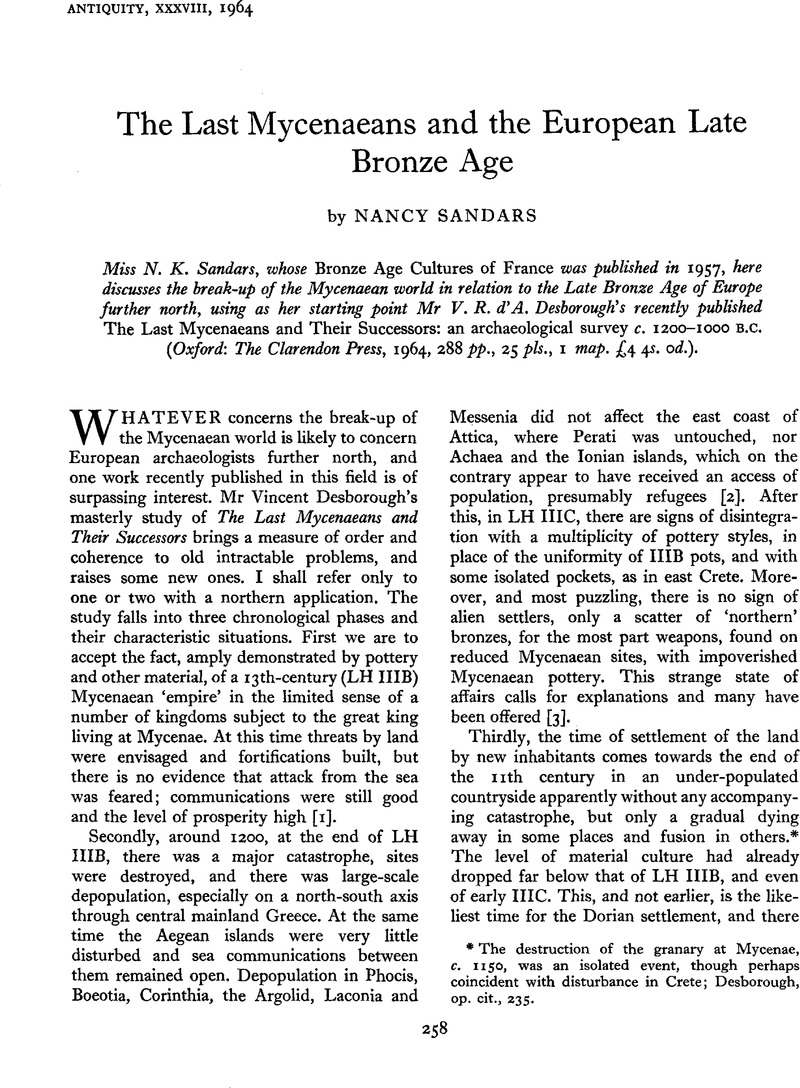Published online by Cambridge University Press: 02 January 2015

Page 258 of note * The destruction of the granary at Mycenae, c. 1150, was an isolated event, though perhaps coincident with disturbance in Crete; Desborough, op. cit., 235.
Page 259 of note * The most convincing evidence in favour of the Adriatic route is at present the Type II sword from Scutari, Albania, but as it is too damaged to classify in Catling’s Groups it could equally well be early (Group I) on the way down to the Aegean, or returning like the refugees to the Ionian islands; Catling, , PPS, XXII, 1956, 117 Google Scholar.
Page 260 of note * Correspondence between the king of Ugarit and Alasiya-Cyprus shows the degree of panic caused by as few as eight ships of the raiders when the home force was already engaged elsewhere. Iraq, XXV, 2, 1963, 120–21 Google Scholar.
[1] V. Desborough, The Last Mycenaeans and Their Successors (1964), 219, 220.
[2] Op. cit., 227–9.
[3] Most recently Prof. Kimmig, W., ‘Seevölker- bewegung und Urnenfelderkultur’, Studien aus Alteuropa, 1964, 220Google Scholar, but evidently written some time before.
[4] Op. cit., 252, more convincing than the ‘literary’ explanation of C.A.H., 11, ch. XXXVI, ‘The end of Mycenaean Civilization and the Dark Age: (B) The Literary Tradition’.
[5] Catling, ‘A New Bronze Sword from Cyprus’, antiquity, 1961, 115; Desborough, op. cit., 1964, 66–7, pi. 22, c and d; Powell, , ‘The Inception of the Final Bronze Age in Middle Europe’, PPS, 1963, 214, 217–19 Google Scholar; Dendra, tomb 12, corselet and bronze cheek-piece for boar’s tusk helmet, JHS, 1960–61, Arch. Reports, 9; AJA, 1963, 145; BSA, 47, 1952, 256; Muller-Karpe, , Germania, 40, 1962, 255 f.Google Scholar favours a predominantly south-north direction but extending over a much longer period.
[6] Catling, loc. cit., 1961, fig. 1; Cowen, , ‘The flange-hilted cutting sword of bronze’, Bericht über den V. Int. Kong, für Vor-und Frühgeschichte, Hamburg, 1958, 207Google Scholar.
[7] Powell, loc. cit., 1963, 226, 219. Even if the abandonment of the Hungarian ‘tells’ at the end of Mozsolic’s Bronze III were brought down as late as 1200 the succeeding Bronze IV is still a continuation, though on different sites. Felsoszöcs pottery, etc., Acta Arch. Hung., 1960, pl. LXXI.
[8] Desborough, op. cit., 1964, 243, 251.
[9] Kimmig, loc. cit., 1964, 223–4 with refs.
[10] Hutchinson, R. W., Prehistoric Crete (1962), 91 f.Google Scholar; R. D. Barnett, ‘Early Shipping in the Near East’, antiquity, 1958, 220.
[11] Powell, loc. cit., 1963, 232: Komarow antecedents to Čaka-type pyre-graves.
[12] Piggott, ‘A Late Bronze Age Wine Trade?’, antiquity, 1959, 122. On the practice of carrying off useful craftsmen see the record Hittite, Goetze, A., Iraq, xxv, 2, 1963, 129 Google Scholar.
[13] Müller-Karpe, , Beiträge zur Chronologie der Urnenfelderzeit (1959), 182 f.Google Scholar and chronological table.
[14] Garašanin, M., ‘Neolithikum und Bronzezeit in Serbien und Makedonien’, BRGK, 39, 1958, 125.Google Scholar The sword is now lost; information kindly given by Mr Cowen who tells me that on the evidence of the drawing it does not appear to be an early type; Albania Antica, 1, Komani, pl. 25; Zara, pi. 38, cist-grave.
[15] Andronikos, M., ‘An Iron Age Cemetery at Vergina, near Beroea’, Balkan Studies, 2, 1961, 8s Google Scholar; Deltion (1960–1), 218 f., and Desborough, op. cit., 1964, 38, 145.